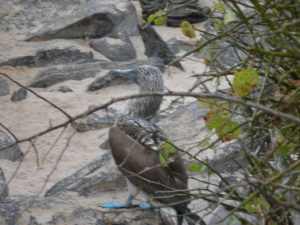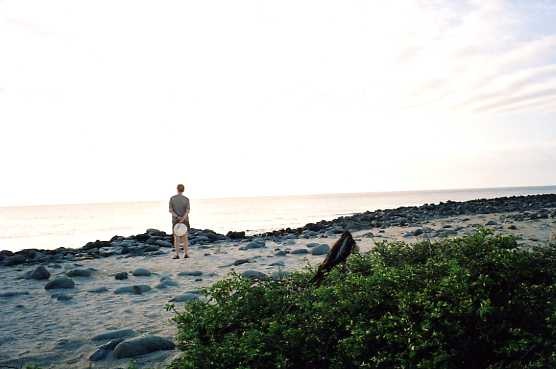
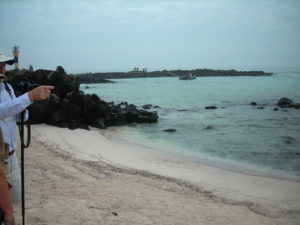 The next morning we were up at 6 a.m. to see Española (Hood) Island at Punta Suarez. The guide for our group was Grace.
The next morning we were up at 6 a.m. to see Española (Hood) Island at Punta Suarez. The guide for our group was Grace.
Animals spotted: Sea lions, blue-footed boobies, red-headed (lava) lizards, mockingbirds, pink iguanas, Sally Lightfoot crabs, albatrosses, gulls, Nazca boobies, heron, Galápagos doves in the rocks on the path, and finches – cactus, warbler, and small ground finches.
Española is one of the oldest of the islands at 3.5 million 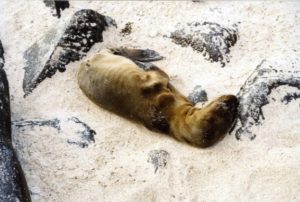 years old. A baby sea lion was asleep right next to the path onto which we disembarked. A booby sat on the park sign. A mockingbird landing in the sand near me and squawked repeatedly. On the beach, a sea lion came out of the water and launched itself at our group while barking
years old. A baby sea lion was asleep right next to the path onto which we disembarked. A booby sat on the park sign. A mockingbird landing in the sand near me and squawked repeatedly. On the beach, a sea lion came out of the water and launched itself at our group while barking 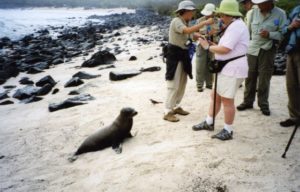 aggressively, and Grace made us back off. (She really didn’t have to instruct us in this!) It sniffed the sand where our footprints were, then plopped down right there and went to sleep, while the mockingbird circled on its thin legs and squawked the whole time.
aggressively, and Grace made us back off. (She really didn’t have to instruct us in this!) It sniffed the sand where our footprints were, then plopped down right there and went to sleep, while the mockingbird circled on its thin legs and squawked the whole time.
The path was difficult to negotiate, all large, dark volcanic 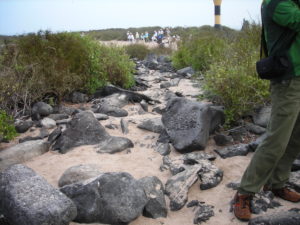 rocks.
rocks.
On the path, while Grace spoke, a blue-footed booby sat down next to her and stared at her, then watched each of us in turn as we passed.
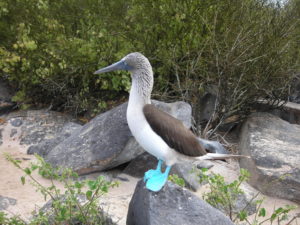 The finches, according to Grace, attack the abandoned Albatross eggs, rolling them against the pointed rocks until they crack.
The finches, according to Grace, attack the abandoned Albatross eggs, rolling them against the pointed rocks until they crack.
At the cliffs, a mockingbird ate from an opened albatross egg while we watched, and then a lava lizard charged the bird and scared it off, though it did not go far, and ate of the egg, too. Grace said that she had never seen before, so she took photos.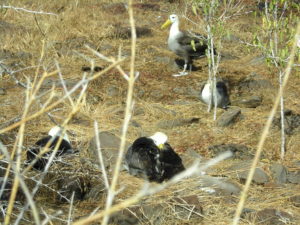
I took this photograph (below, left) of a juvenile Nazca booby that was standing on a rock just feet from me.
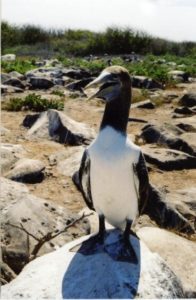 On the panga back to the ship we see three sea lions playing with an obviously dead iguana. Later we learn that this is a routine hazard for
On the panga back to the ship we see three sea lions playing with an obviously dead iguana. Later we learn that this is a routine hazard for 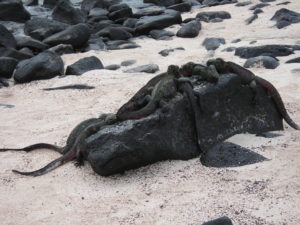 marine iguanas – the sea lions don’t mean anything by it.
marine iguanas – the sea lions don’t mean anything by it.
